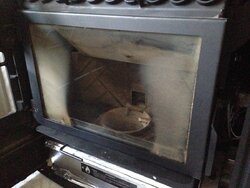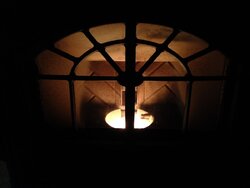I've been brainstorming ways to get more heat out of some seriously terrible pellets that I'm burning this year. Before I started burning these pellets, I thought that "low heat" claims that others have complained about were overblown, and that pellet quality had mostly to do with ash buildup. Well, I was wrong, so I had to figure out how I was going to get enough heat to stay toasty this winter.
The first thing that peaked my interest was a website that tested and compared different pellet stoves on different characteristics: heat output, cleanliness of glass, efficiency, etc. (http://www.forgreenheat.org/decathlon/sefficiency.html). The website made the following observation:
"The very high levels of oxygen in the stack of the these six stoves may indicate that pellet stove manufacturers are sacrificing efficiency in order to provide enough air to keep the glass clean. Stoves that have an air-wash for the glass are actually leaking air in, usually beneath the glass surface. This friction across the glass from the air allows the glass to stay clearer. Our most efficient stove, the Piazzetta, also had the dirtiest glass, which may be a sign that they prioritize higher efficiency combustion over seeing the flame."
The idea to mess with the airwash to increase heat output was then further solidified by a prior thread, in which some quad owners reported serious heat gains by blocking the airwash: https://www.hearth.com/talk/threads/airwash-experiment.82190/
Theoretically, by blocking the airwash (either partially or fully), four things will improve efficiency:
1. Because less room air is getting sucked into the firebox, the air headed to the heat exchangers will be hotter.
2. Because less total air is moving through the combustion system, the airflow over the heat exchangers will slow and have more time to transfer heat.
3. More air (although not as much as was pulled through the airwash) is pulled through the burnpot, improving the burn.
4. The air sucked through the airwash is no longer causing drafts in your house.
So I decided to try it. I blocked the airwash completely with a rope gasket, and turned the stove on high. I noticed three things. First, most obviously, the glass got dirty FAST (likely made worse by the dried dung pellets I'm working with). Second, the heat output was outrageous. I didn't have a thermometer on hand to take a reading, but there was a massive heat improvement. I was actually concerned I was going to damage the stove somehow. And fourth, as expected, the burnpot was ejecting a lot of large embers due to the increased airflow through the burnpot holes. In fact, zero ash accumulated in the burnpot during the test.
The large expelled embers were definitely an inefficiency in the new setup. If I wanted to pursue this experiment further, I would have partially obstructed my OAK so as to reduce airflow. This would have improved heat output even more as the burn would be more efficient and the hot air would move even slower over the heat exchangers. I did not do this, however, due to concerns that I would overheat something. And in any case, it wasn't acceptable to me to have glass that dirty all the time.
Next, I cut two 2-3 inch pieces of rope gasket and repeated the experiment with only the ends of the airwash blocked. I noticed that the heat was still significantly better than it was with an unblocked airwash, although not quite as good as when the airwash was fully blocked. The air coming through the burnpot was also not so strong that it blew large embers out of the pot. You can see in the photo below that the glass got dirty on the sides of the glass, but stayed clean in the center. In effect, I made my garbage pellets into high heat pellets by sacrificing glass clarity. This is more than acceptable to me.
Takeaways:
1) Castiles and Santa Fes can be easily tuned to trade glass clarity for efficiency.
2) Much (I think most) of the gains can be achieved by sacrificing about half of the glass area.
3) If you want to get maximum efficiency and don't care about what the glass looks like, and you block the entire airwash, you should also consider partially blocking your OAK to reduce air flow through the burnpot.

Thanks for reading!
The first thing that peaked my interest was a website that tested and compared different pellet stoves on different characteristics: heat output, cleanliness of glass, efficiency, etc. (http://www.forgreenheat.org/decathlon/sefficiency.html). The website made the following observation:
"The very high levels of oxygen in the stack of the these six stoves may indicate that pellet stove manufacturers are sacrificing efficiency in order to provide enough air to keep the glass clean. Stoves that have an air-wash for the glass are actually leaking air in, usually beneath the glass surface. This friction across the glass from the air allows the glass to stay clearer. Our most efficient stove, the Piazzetta, also had the dirtiest glass, which may be a sign that they prioritize higher efficiency combustion over seeing the flame."
The idea to mess with the airwash to increase heat output was then further solidified by a prior thread, in which some quad owners reported serious heat gains by blocking the airwash: https://www.hearth.com/talk/threads/airwash-experiment.82190/
Theoretically, by blocking the airwash (either partially or fully), four things will improve efficiency:
1. Because less room air is getting sucked into the firebox, the air headed to the heat exchangers will be hotter.
2. Because less total air is moving through the combustion system, the airflow over the heat exchangers will slow and have more time to transfer heat.
3. More air (although not as much as was pulled through the airwash) is pulled through the burnpot, improving the burn.
4. The air sucked through the airwash is no longer causing drafts in your house.
So I decided to try it. I blocked the airwash completely with a rope gasket, and turned the stove on high. I noticed three things. First, most obviously, the glass got dirty FAST (likely made worse by the dried dung pellets I'm working with). Second, the heat output was outrageous. I didn't have a thermometer on hand to take a reading, but there was a massive heat improvement. I was actually concerned I was going to damage the stove somehow. And fourth, as expected, the burnpot was ejecting a lot of large embers due to the increased airflow through the burnpot holes. In fact, zero ash accumulated in the burnpot during the test.
The large expelled embers were definitely an inefficiency in the new setup. If I wanted to pursue this experiment further, I would have partially obstructed my OAK so as to reduce airflow. This would have improved heat output even more as the burn would be more efficient and the hot air would move even slower over the heat exchangers. I did not do this, however, due to concerns that I would overheat something. And in any case, it wasn't acceptable to me to have glass that dirty all the time.
Next, I cut two 2-3 inch pieces of rope gasket and repeated the experiment with only the ends of the airwash blocked. I noticed that the heat was still significantly better than it was with an unblocked airwash, although not quite as good as when the airwash was fully blocked. The air coming through the burnpot was also not so strong that it blew large embers out of the pot. You can see in the photo below that the glass got dirty on the sides of the glass, but stayed clean in the center. In effect, I made my garbage pellets into high heat pellets by sacrificing glass clarity. This is more than acceptable to me.
Takeaways:
1) Castiles and Santa Fes can be easily tuned to trade glass clarity for efficiency.
2) Much (I think most) of the gains can be achieved by sacrificing about half of the glass area.
3) If you want to get maximum efficiency and don't care about what the glass looks like, and you block the entire airwash, you should also consider partially blocking your OAK to reduce air flow through the burnpot.

Thanks for reading!


 You can Private Messaging me if you have any questions on these mods.
You can Private Messaging me if you have any questions on these mods. 